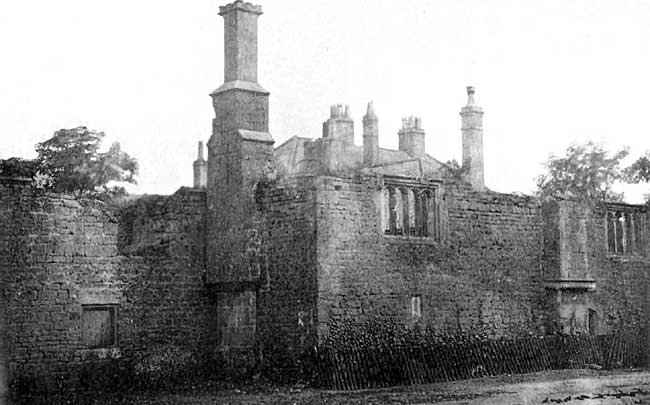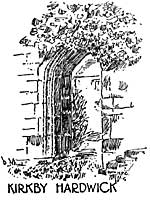Hardwick—Hardwick-upon-Line—Kirkby Hardwick
BY MR. GEO. G. BONSER.

Kirkby Hardwick.
Hardwick derives its name from the Anglo-Saxon hard or herd—a company of people, or a flock, from Heorod, an assembly, and wic—a station or abode, probably implying a military station.
Hardwick-upon-Line is the name by which it was known to Leland in 1549. "The Erle (Shrewsbury) hath a parke and a manor place or lodge yn it caullid Hardwike-upon-Line, a four miles from Newstede Abbey." This is most probably derived from the fact that in every perambulation of the Shire wood it stood on the boundary line between the forest and the private lands of Kirkby, the name of the parish in which it stands.
In 1735 it was also known as Sutton Hardwick. In nearly all the perambulations of the forest it has been a landmark, that of A.D. 1232 giving the bounds as follows:— "from the Milleford to Mayneshead, from thence between the fields of Hardwick and Kirkby to the corner that is called 'Nun Carre.'"
I may state in passing that the local authorities have discarded this latter name for the prosaic one of "Mutton Hill." A deed is in existence in the possession of His Grace of Portland, dating from internal evidence c. 1240, in which "William, son of William of Herdywyk grants and confirms to Henry de Perepunt and his heirs, or to whomsoever he may wish to give, sell, or assign as well on his deathbed as in his lawful power, eight acres of land in the field of Herdywyk, to wit, five acres in the field towards the south, between land of Galfredus Fitzranulph de Sutton . . . and land of my own ... at the annual rent of 6d" 3d at Easter and 3d at the feast of St. Michael. The witnesses being Dom. John de Stuteville [of Kirkby], Dom. Nich. Spigurnell [of Skegby], Dom. William, parson of Kirkby, Dom. Gerard de Sutton, Robert Torkard, John de Perepunt, Reginald Parcus."
In 1378, Robert of Eton gave, granted, and confirmed to Reginald de Grey all his land and tenements in Herdewik in the p. of Kirkby, dating it at Herdewik, Thursday next before the Feast of the Annunciation of the B.V. Mary 1, Rich. II., 1378.
In 1382, R. de Grey conveyed it to Sir John Babrichecourt, knight, with its lands, tenements, rents and services.
In 1449, Sir Henry Pierpoint, knight, released to Richard Illyngworth and his heirs all his rights in a Medow called Akbrigge, near Hardwick, and in all the Lands and Tenements in the fields and gardens of Hardwick; this being confirmed in 1452 by Elena Pierpount, widow, late wife of Henry Pierpont.
The same year, Richard Illyngworth conveyed it to William Kyrkby, son of John Kyrkby and Robert Langton, son of John Langton, his manor of Hardwyk, for the purpose of making a settlement in the marriage of his son Ralph to Agnes Nynne. In 1481, the custody of a water-mill called Sutton Mill, in the Forest of Shirewood, between Mansfield and Hardwick, was committed to him.
Sir William Conyers, knight, 18 H. VII. (1503), made a recovery against Richard Illingworth for the manor of Hardwick with its appurtenances, One Messuege & 600 acres of land, calling to witness John Illingworth.
In 1517, by an indenture made thirteenth March, 8 H. VIII., Sir William Conyers, knight, Lord Conyers bargains & sells the manor or chief messuage of Hardwick in the p. of Kirkby, co. Notts to George, Earl of Shrewsbury. The consideration money was £200.
And now we come to the part that Hardwick plays in the history of the country. I would carry your minds back to a gloomy day in November of the year 1530, about the 24th to the 26th, when slowly approached to the door of this house the once powerful ecclesiastic but now degraded statesman, Cardinal Wolsey, the most interesting personality of his time, at once beloved and feared. I give a contemporary account written by George Cavendish, a few years later, 1557. " And the next day he took his journey, with Mayster Kyngston & the gard. And as son as they espied ther old mayster in such a lamentable estate, lamented hym with wepyng eyes. Whom my lord toke by the hands & dyvers tymes by the way, as he rode, he wolde talke with theme some tyme with oon and some tyme with an other. At nyghte he was lodged at an howse of therle of Shrewsbury called Hardwyke Hall; very evyll at ease. The next day he rode to Notyngham & ther lodged that nyght, more sikker, & the next day we rode to Leycester Abbey."
It will not require much imagination for us to view them as we gaze upon the ground trodden by this miserable man and his heavy hearted companions, and we may moralise upon the futility of human ambitions, and perhaps realise more fully the depths of his despair when he uttered those now familiar words " Had I but served my God with half the zeal I have served my king, He would not in mine age have left me naked to mine enemies."
Some idea of the surroundings of this house at that time maybe obtained from an Inquisition taken January 15th, 1529, by the abbot of Welbeck and Roger Greenhalgh, inter alia, that in the woods of Sutton Forest there were 238 red deer, of which 53 were deer of antler. Hardwick was stated to be the property of Sir Charles Cavendish in the Inquisition taken on his death in 1617, and his son William, afterwards Earl of Newcastle, succeeded to it.
During the Civil War, the Earl garrisoned Felley Abbey, seizing there £1,713, for which Gilbert Millington was granted the income from land at Kirkby Woodhouse by the Committee for Compounding. Probably he would also garrison Hardwick, as it would be directly on his line of communication from Welbeck. Early in the 19th century it became the property of His Grace the Duke of Portland, its present owner.

With regard to the walling and buildings that remain the oldest part seems to date only from the Tudor period, showing the flattened arches and low rooms of the time, but not much of any architectural beauty. Some effort has been made to identify a chapel, but nothing at all conclusive has been obtained, A romantic and beautiful tale of the late S. T. Hall's, to the effect that a monk was permitted by the owner of Hardwick, for many years after the dissolution of the monasteries to return for private prayer in its chapel, seems to be entirely unsupported by evidence.
Mr. William Stevenson suggests that it was built and fortified during the Wars of the Roses, the latest part of the original buildings being the upper floor added about 1520. The lower walls were thick enough to carry the upper, but not the fire-places and chimney stacks . . . pillars were therefore placed on the outside to carry the projecting mass. The building of the most modern part is 18th century, when the Italian fish-pond was made. The great thickness of the eastern loop-holed walls suggests that it was the ground storey of some great building overhead, taken down when the modern building was erected, the present wall being retained for the enclosure. " The stonework details of the gateway square with the works at Nottingham Castle erected by Ed. IV., 1461."
It seems to me equally probable that the walls were loop-holed by the Earl of Newcastle when he was garrisoning Felley. Some of the later buildings were erected towards the end of the 17th century, one stone being marked W. C., 1672.
This may be intended for William Cavendish, the owner, or it may allude to William Clarke, the then occupier. His descendants continued to reside here till the last representative died 2nd February, 1653, when the Hodgkinsons, an old Kirkby family, came to it. It is now occupied by Mr. Sanders.
